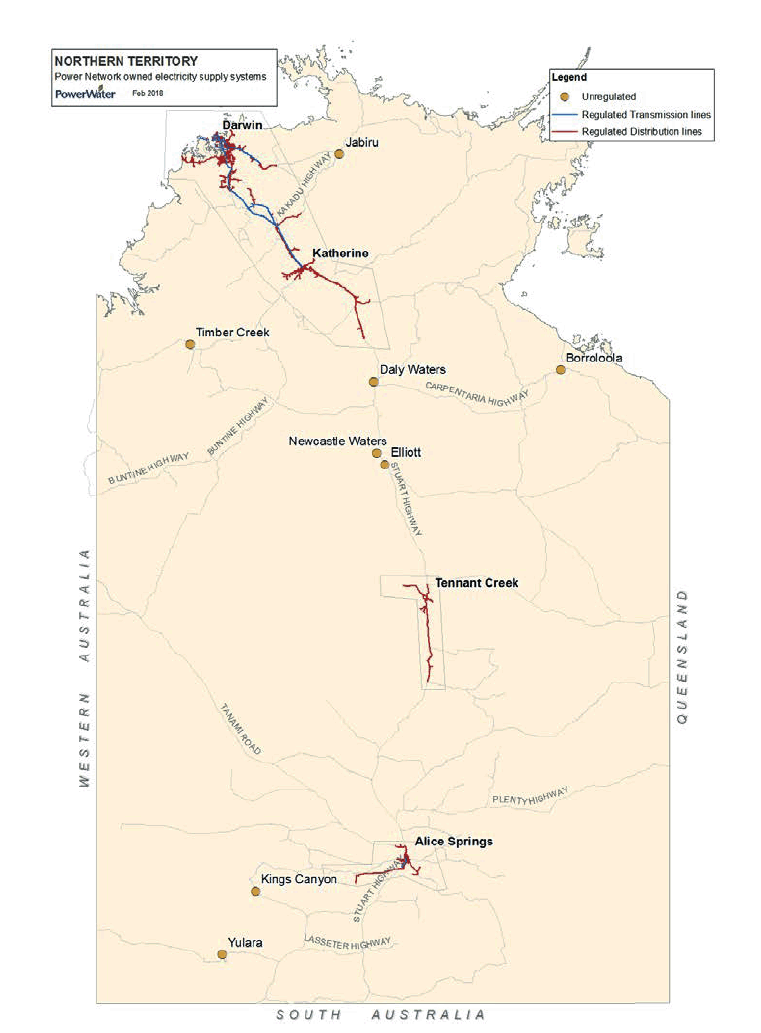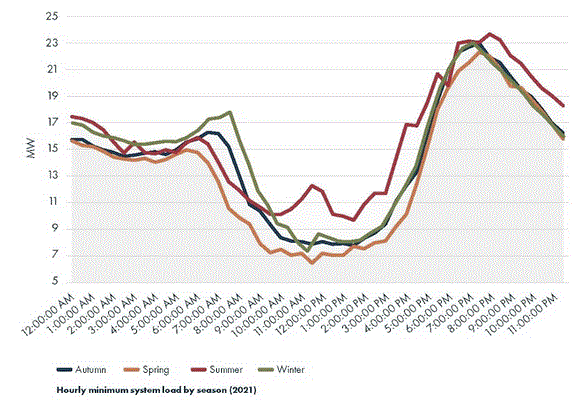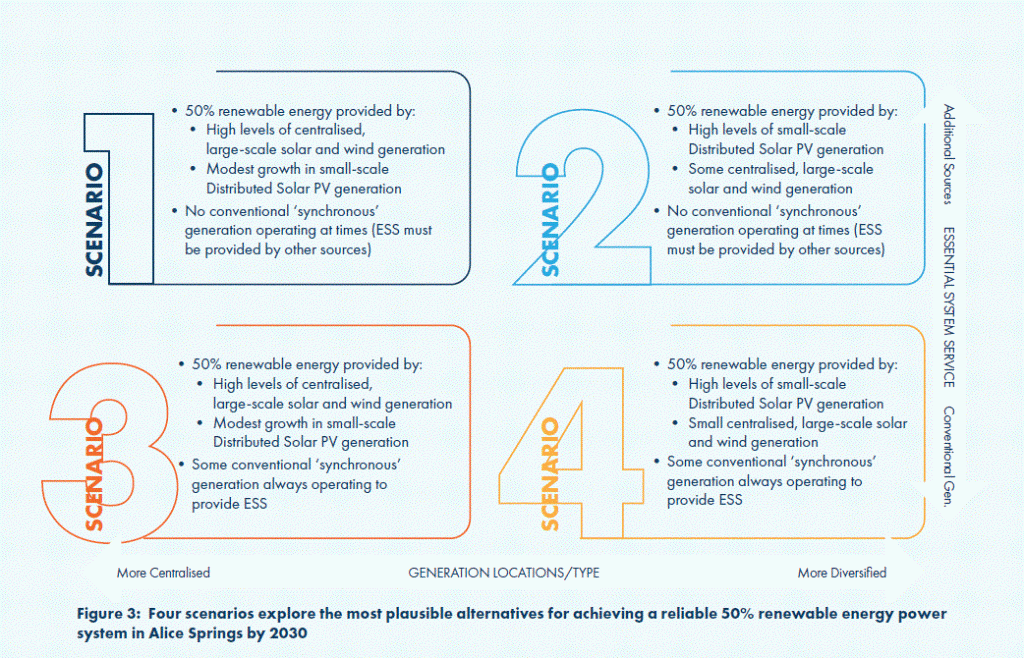Ponder how destructive solar power is: It only takes 13% solar to push a small grid to the edge
A little bit of solar power causes mayhem on a perfectly good grid.

NT Electricity Grid Map (Click to enlarge) Darwin is 1,300 km or 800 miles in a straight line from Alice Springs.
The Renewable Crash Test Dummy Country is aiming to be using 82% renewable electricity by 2030, but instead of making sure this works on a small scale at any one of our remote microgrid locations, where electricity is expensive to start with, we thought we’d do the experiment on the whole nation instead.
So it is “sobering” to see how this fails at Alice Springs. If there was a place on Earth that is well suited to wind and solar power, it surely is Alice Springs which is 1,200 kilometers from the Northern Territory’s main electricity grid. Surrounded by a million square kilometers of largely uninhabited arid land, if we can’t plaster enough solar panels and windmills here to support a town of 25,000 people with no heavy industry to speak of, where can we?
Yet the bare truth is that solar energy provides just 13% of Alice Springs annual electricity, and fossil fuel based generation, they admit quietly near the bottom of an FAQ page, is, shhh, 87%. Only one in four houses has solar power, yet the grid is already overloaded when it peaks, and unstable when a cloud comes over and the whole towns solar power goes down. (As it did in 2019 leaving many homes blacked out, as the engineers predicted would happen).
So the “news” that the ABC reports is that someone has a plan to push Alice Springs from 13% to 50% renewable energy by 2030. Despite this daunting task, ponder that the ABC is excited today that one small, extremely sunny isolated location might, in our wildest dreams, manage to achieve a bit more than half the target we set for the whole nation by 2030, but only if we spend $150 million (and over 20 years?).
This is called “Leading the Country” — where they fail to meet the targets before everyone else does…
When Victoria Ellis says “energy” below she means electricity.*
Alice Springs can be powered by 50 per cent renewable energy in six years, report shows
By Victoria Ellis, ABC “News”
According to the Alice Springs Future Grid website, about a quarter of Alice Springs homes have solar panels, and over a year about 13 per cent of the town’s energy comes from solar, but if more solar energy is added without further planning, the small electricity grid could become unstable.
The Alice Springs Future Grid website says if solar panels across the town are generating a lot of power in the middle of the day and a cloud bank suddenly shadows them, their electricity production may drop more quickly than an alternative power source can be drawn upon, leading to a blackout.
Alice Springs Future Grid director Lyndon Freason said in today’s system, there is sometimes lots of solar being produced that is not used by the grid.
“It’s becoming increasingly difficult to efficiently absorb more renewables in the middle of the day when the sun is shining, without actually causing instability in the existing generation,” he said.
So the only problem with solar power is that there is either too much electricity or not enough, or it disappears when the clouds come over, needs constant back up, and it can’t stabilize the frequency, right? And then there is the duck curve. Look at the ramping rate required from 4 to 6pm:
The belly of the duck is the fall in the need for electricity at noon as solar peaks. The belly can’t be allowed to sink too far, because the gas/diesel power plant needs to keep running to keep the frequency stable.
The “Roadmap” such as it is, is four scenarios with a bit more-or-less of this and that:
Click to enlarge (From the PDF)
The costs, the costs:
I don’t know if anyone has mentioned that 2030 is not 20 years away:
Mr Cocking [CEO of Desert Knowledge Australia] estimated implementing one of the scenarios would cost about $150 million over 20 years.
“Ideally it would come from government, but most likely as well some private investment,” he said.
More detailed estimates (page 63) suggest the costs could be as high as $216 million, but there will theoretically be about $50 million in fuel savings.
It still works out as $6,000 per man, woman and child — which no one has to spend at all — because they just built the current diesel-gas power plant there in 2011 and upgraded it in 2018 at a cost of $75 million. Should we ask the people of Alice Springs if they’d rather have the money? For a family of four that’s $24,000. Might be nice?
But as a microcosm of a national transition the Alice Springs mini grid speaks volumes about how absurd the whole crusade is.
Currently when the wind and sun are asleep the town gets electricity from the Owen Springs Power Station which is a gas/diesel plant that can provide 80 megawatts whenever they need it. There is also an old power station built in 1973 that is still operational and a 5MW Battery Energy Storage System (BESS). Proportional to the size of the Alice Springs grid, it is (or was) effectively the “biggest battery” in Australia when it was installed in 2018. It is used mainly for stability and emergency power when the clouds roll over so the gas plant can ramp up. If it were to be used mostly for storage, the $8 million battery would only last about 20 minutes, or maybe 40, tops. This doesn’t scale well to a nation of 27 million people.
For the record, a mini-Snowy 2.0 scheme is not possible in Alice Springs. There are some worthy hilly areas for sure, but annual total rainfall is barely 280mm or 11 inches, and quite random.
Don’t wash those solar panels?
Curiously, the tap water in Alice Springs is worse for the solar panels than the dust is:
Detailed studies have been conducted on this subject, concluding that dust does not have a significant impact on PV systems. This is perhaps surprising, but washing the panels with tap water in places where there is a high concentration of calcium (such as Alice Springs) can actually have a more negative effect than dust. The arrays at the DKA Solar Centre are washed once a year by a specialised company who use a reverse osmosis filtration system to treat their water before using it to wash the solar modules. ( from the FAQ.)
Those key statistics from the FAQ of the “Alice Springs Future Grid” (which is the current grid)
In the 2021‑22 reporting period, total conventional generation capacity was 122.6 MW and operational maximum demand was 48.6 MW, not including requirements for system redundancy. It is noteworthy, however, that while the Ron Goodin power station is aged, it remains available for system redundancy. No definitive retirement date has been announced.
Over recent years, more than 25% of the approximately 9,000 households in Alice Springs have installed DPV on their property rooftops.
The maximum output capacity of all residential DPV systems in Alice Springs is estimated to be 23 MW, and historical generation data suggests in the order of a 9% contribution to overall consumption. Fossil fuel-based generation produced 87% of annual volume and centralised Renewable Generation produced 4%.
See the FAQ for more.
*Obviously solar power is not providing 13% of the towns energy – which also includes petrol, oil and gas.

